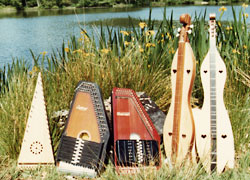
| THE HOBGOBLIN INFO SOURCE | |||
| HOBGOBLIN INDEX PAGE | HOBGOBLIN INFO INDEX | CATALOGUE CONTENTS | FIDDLE ONLINE SALES | SECONDHAND PRICES |
| Fiddle & Violin FAQ | ||
 |
ON THIS PAGE: Under Construction! General Fiddle Advice Violin Construction Violin Setup Fiddle History Violin Pickups and Electric Fiddles RELATED PAGES: Care and Maintenance Fiddle Cracks & Repairs |
 |
|
© Copyright Hobgoblin Music 1983, 2000. This text may be freely distributed in whole or in part so long as the copyright holder is clearly acknowledged. Fiddle HistoryPrimitive bowed instruments of many types exist around the world and some are still widely used, but the modern Violin first appeared in Italy in the early 16th century. Well known early fiddle makers include Guarneri, Amati and Stradivari. The modern classical violin has a longer neck and fingerboard, and a greater neck angle than the original baroque design, in order to provide more volume. Many early violins were modified in the early 1800s to match the requirements of the new design, and can be identified by the grafting on of a new neck. Violin ConstructionThe violin top and back are carved out from solid wood. The top is spruce and the back, sides and neck are generally from maple or sycamore. The bassbar is an integral and tonally important part of the top. The soundpost is fitted about 1/4" behind the treble foot of the bridge and connects the front and back of the instrument acoustically in a way that shapes the sound considerably. The most popular types of hardwood used in violins have a curl in the grain which shows up as a flame effect. The edges of the body are almost always inlaid with a band of purfling. Copies and originals of the Italian maker Maggini will have two separate purflings. Violin General AdviceItalian Violins are very much sought after, French are probably next most popular. Most old violins available are German from the period 1860 to 1935. Many lesser instruments were made in Czechoslovakia, Romania and Hungary and more recently in China and Korea. Basic Violin SetupThe sound post should be close to the foot of the bridge on the treble side of the violin. The closer it is to the bridge, the sharper and louder the sound. Further away, the sound is mellower and quieter. This is best done by your dealer or repairer, but soundpost setting tools are available for the player to buy. To check the position and height of the bridge, roll a biro or pencil around the top of the fingerboard - the distance between the strings and the fingerboard should be approximately the width of the pen. The bridge can be sanded down if necessary, but the feet need to make good even contact with the violin. The bridge normally sits between the notches in the f holes, and it is usual to set the bridge so it leans a very small amount toward the tailpiece.Violin Pickups and Electric Fiddles, by Dom SchliengerIn This Article:
For most fiddlers there comes a time when they consider amplifying their instruments, either to be heard better or to experiment with the possibilities of electro acoustic sounds. Most fiddlers immediately regret even having thought about it the moment they enter the maze of pickups, solid body electric fiddle, microphones, pre-amplification, acoustic amps etc…
And it never quite sounds the way you expected it to!
Nonetheless it is probably fair to say that there is a solution for every fiddler, from the occasional experimenter to the pro who plays in a stadium, and the absolute beginner who pities the neighbours and decides to learn on headphones with a “silent violin”!
Taking the sound from the entire instrument rather than just from the bridge (which is the limitation of most piezzo pickups) is the thought too behind The Band violin Pickup from Headway, which literally wraps around the middle of the instrument. The result is an amazingly warm and rich sound, and a low impedance signal, which means that very little or no preamplification is needed.
The most popular pickup system consists of one or two little metal plates with an imbedded piezzo crystal which slots into the wings on the bridge of the violin. The Fishman V200 Violin transducer and the BM0715 Shadow SH941 Violin Pickup are good examples of this. A very accurate brilliant signal is characteristic of this system. As the pickup actually blocks the wings of the bridge, the acoustic sound will be slightly muted, and the sound on the pick up doesn’t necessarily represent the actual sound of your violin. This doesn’t need to be a problem though! In many cases it turns out that a very cheap, average sounding acoustic fiddle actually sounds great with the pick up! Many fiddlers go that way and often take a step further by super-glueing the pick up permanently to the bridge, (This prevents the pick up coming loose while playing, which makes a very unpleasant noise) lining instrument body with foam to minimise feed back, or closing the F-hole with transparent sticky tape. Obviously these steps don’t do much for the acoustic sound of the instrument, and players who do this will probably keep another, untampered-with instrument for acoustic use.
There are systems however, which can be permanently fixed and don’t mute the instrument. The Shadow SH940 is one of these, and is a whole traditional bridge with a piezzo transducer built into the bridge body rather than the wings. Also available is the Schaller Violin Pickup 10/80 which has a surprisingly warm, round and pleasant tone.
The main difference between a solid body fiddle and an acoustic one is, obviously, that you will hear a lot less of the actual instrument while playing. This means that good monitors are crucial. Usually the best way to ensure you get the sound you need is to have your own amp which you can take along to gigs and sessions. For violins, - solid body or with a pick-up fitted- acoustic amps (Or keyboard amps as it happens!) are a lot better than electric guitar amps. Electric guitar amps are built for the (Restricted) frequencies of the electric guitar. (Most violins, when plugged straight into an electric guitar amp sound tinny, nasal and squeaky.) AER does a fantastic range of affordable high end acoustic amps, (Starting at around £385.00) For home use the Ashbury acoustic amps will probably fit the bill nicely. If you prefer to hear the actual instrument while playing, electro acoustic fiddles like the European built Ashbury Electro Acoustic Violin are an affordable solution. The fact that solid body instruments are actually “silent” is used as an advantage in the range of “silent Violins” which were originally intended as practice instruments enabling you to play in the middle of the night without disturbing neighbours, etc. That’s why the Silent Electric Violin Outfit includes Headphones which plug straight into the onboard pre amp. The more professional version made by Yamaha has become one of the most popular electric violins on many stages. Strings for ElectricsYou can use normal violin strings on an electric violin. For frame or solid body electric violins (ie not an electro-acoustic), strings with a steel core (as opposed to Nylon) will give you the best response.Back to the Top of the Page |